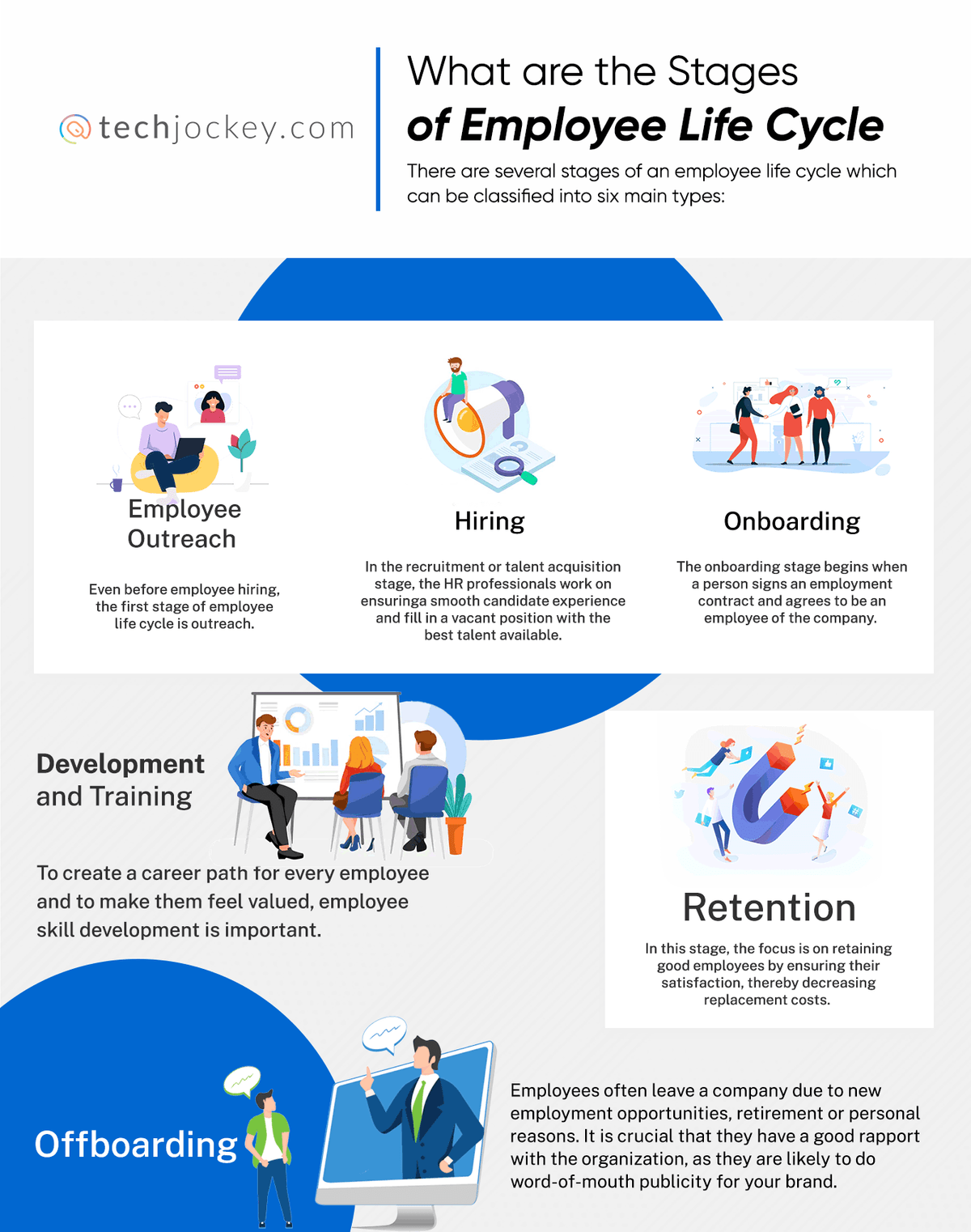Employee Life Cycle Management with PeoplesHR

Employees are the backbone of any organization. A good employee experience can boost overall productivity and help in successfully achieving the goals of an organization. Therefore, it is a top priority for the HR department of any flourishing company.
However, there are several challenges throughout an employee’s journey, starting from finding the right talent to upskilling and nurturing employees.
Additionally, the hybrid model demands new methods and strategies for improving the employee experience and reducing turnover. For this, HR professionals need further to optimize the journey of employees through well-defined lifecycle management.
This article discusses employee lifecycle management strategies that would help HR professionals ensure employee well-being and growth.
What Is Employee Lifecycle Management?
Employee lifecycle management is the process of streamlining different stages that an employee goes through during his/her tenure with the organization.
This includes everything from managing how an organization recruits and onboard employees, ensuring their training & development, and creating new opportunities for them to grow. It is the task of the HR department to find ways of ensuring that employees and the organization have a positive relationship.
What are the Stages of Employee Life Cycle Management?

There are several stages of an employee life cycle which can be classified into six main types:
- Employee Outreach
Even before employee hiring, the first stage of the employee life cycle management is outreach. At this stage, any organization works on creating an employee-centric work culture that motivates the existing employees and the potential candidates.
Some of the strategies adopted by companies to create an encouraging work culture are flexible work hours, fair compensation, additional perks, inclusivity, etc.
The employee outreach stage impacts the way potential employees perceive the organization. This step is vital to an organization’s growth as it helps attract the best talent that contributes to the new initiatives.
- Hiring
In the recruitment or talent acquisition stage, the HR professionals ensure a smooth candidate experience and fill in a vacant position with the best talent available. Candidates are informed about their recruitment status at every stage, along with feedback.
This is done by creating a well-defined outline of job roles and prerequisites that can be published further. HRs also pull in candidates through employee referrals as well as multiple recruitment platforms.
Strategies in this stage are also based on the demographic suitability for a job role. The hiring data from this stage can also be used to analyze and improve future recruitment strategies.
- Onboarding
The onboarding stage begins when a person signs an employment contract and agrees to be an employee of the company. This stage includes staying in touch until they join the company, providing relevant information and tools for getting started, including newbies in communities and events, etc.
HR managers ensure that employees feel welcomed by their team on their first day for both remote and office units. Regular feedback is important during this stage so that adjustments and improvements can be made.
This stage helps the new employees adjust to the work environment and makes them understand the culture and other positional aspects that they can adapt to.
- Development and Training
To create a career path for every employee and make them feel valued, employee skill development is important. This can be based on the relevant personal interests of the employees, company goals, or what their managers feel should be part of their upskilling plan based on the current performance.
Most companies cover the expenses for seminars, conferences, and other ways employees can grow their industry knowledge. This way, employees don’t feel stuck in their roles.
- Retention
In this stage, the focus is on retaining good employees by ensuring their satisfaction, thereby decreasing replacement costs. By hiring the right talent who fits in the company culture, a part of the work is done.
In this stage, HR professionals work on maintaining clear and respectful communication among team members. The use of 360-degree feedback has also become popular to help solve employee issues on an ongoing basis.
For instance, there might be issues with colleagues, supervisors, or any software usage that demand immediate resolution. With a robust help desk system, employers can ensure timely resolution.
- Offboarding
Employees often leave a company due to new employment opportunities, retirement, or personal reasons. They must have a good rapport with the organization, as they are likely to do word-of-mouth publicity for your brand.
It is the task of HR professionals and team leads to ensure minimal impact on other team members and their morale remains high. Most companies take exit interviews to understand the separation cause so that they can improve in the future.
Many companies even maintain an alumni network so that ex-employees can engage with the organization, give honest feedback on developments, and even come back if they want.
Why is Employee Lifecycle Management Important?
Employees are the essential asset of an organization, and you need to nurture them and create growth opportunities.
- Retain talent and reduce turnover
If you make efforts to ensure employee satisfaction, there are high chances of a low turnover rate. You can allocate the right resources to employees and learn from your previous mistakes. When employees feel welcomed, it helps avoid recurring training costs for new employees.
- Bring more profits by being productive
Effective employee lifecycle management can improve employee engagement by resolving their issues and providing them a path to grow. They will not be slacking and waiting for a paycheck but rather get more work done easily. This will bring in more opportunities and profits to the organization.
- Improve customer experience
Happy and well-appreciated employees will give their best to ensure that customers are satisfied. They will try to come up with new and innovative ideas and feel more loyal to the company. This, in turn, will boost business growth significantly.
- Positive brand reputation
How employees feel during their journey with your organization impacts their perception, and they are likely to convey the same to the outside world. A positive experience where they have grown both professionally and personally helps build a better brand image. This contributes to more talented candidates and hence the more promising business.
6 Proven Tips for Employee Life Cycle Management

For a better candidate and employee experience, you can consider the following tips:
- Create a Positive Brand Reputation for Talent Acquisition
Potential candidates are quite likely to visit your company website and social media to learn about the business. A well-built website reflects a good image of the brand.
Ensure that it is easy to navigate, highlights the USPs and achievements of your organization, and creates a great impression. Also, create engaging social media content for candidates where they can know more.
- Maintain Clear Communication During Recruitment
Be clear about the job roles and your expectations in front of the talent pool. Presenting unrealistic expectations will make employees disappointed later, and they might even quit.
- Adopt an Ongoing Onboarding Process
Don’t make the mistake of limiting onboarding activities to the first week. The onboarding process should continue for the initial months until new employees get well-versed in their roles and work culture. This is crucial for long-term retention.
- Training Programs for Upskilling Employees
To ensure that employees retain information better during online or offline training, apply engaging techniques. For example, gamification and breaking down data in small chunks have been proven effective for online learning. Also, instead of hiring a new trainer, you can go with peer-to-peer mentoring for easier understanding and build professional relationships.
- Improve Employee Morale through Recognition
Motivation and appreciation are essential for boosting employee morale. Create a reward & recognition system for your employees so that they continue performing in the long term.
- Create an Offboarding Checklist
Keep a checklist for employee offboarding to prevent any hassle. The tasks can include taking feedback, removing IT access, managing paperwork, etc.
Why Use Employee Lifecycle Management Software?
Employee lifecycle management software can help achieve the following:
- Reduced burden on HR department
Employee lifecycle management software automates the entire process from outreach to offboarding with a single, centralized platform. This decreases the burden on HR professionals who don’t have to indulge in repetitive administrative tasks.
- Organizational improvements
With software, it becomes easier for HR managers and other people in the management to analyze employee data. Due to accurate identification of problems and vulnerabilities, decision-making ability improves, and employee satisfaction grows.
Peoples HR Turbo is a holistic HR solution with built-in reporting capabilities to help managers optimize their employee lifecycle management.
- Transparency
An employee lifecycle management system consists of data of all stages in one single platform. This includes performance details, compensation data, feedback, and more. Hence, a single source of information is accessed by all departments, thereby preventing confusion and inaccuracies.
- Data security and privacy
Sensitive employee data stored in the software is easy to search for and cannot be missed. Employee lifecycle management solutions have data privacy and security features to protect and store employee information safely.
It is good to look for standards and certifications while choosing employee lifecycle management software for yourself. If you consider PeoplesHR Turbo software, it is security certified by Ernst and Young (EY). The data is hosted on Microsoft Azure and is therefore encrypted, ensuring privacy.
- Compliance
Employee life cycle management software help ensure compliance with employment practices easily. The software keeps HR departments up-to-date with the latest government regulations for the employees.
PeoplesHR Turbo: A holistic HR solution
Given the importance of effective employee life cycle management, any organization needs to use the most suitable software solutions for their success. There are several HRIS solutions in the market, such as Peoples HR Turbo, that you can use to track every step of the employee lifecycle and take relevant actions.
PeoplesHR Turbo even have a self-service portal for employees, promoting transparency and personalize every employee’s experience. Employees can update and access their information easily and feel more involved in the entire process.
It’s a complete HR management solution, which assists in managing the entire employee lifecycle. From employee information to attendance & absence, and reporting, everything can be managed through a single interface.
Ayushee is currently pursuing MBA Business Analytics from SCMHRD, Pune with a strong background in Electronics and Communication Engineering from IGDTUW. She has 2 plus years of full-time work experience as an SEO content writer and a Technology Journalist with a keen interest the amalgamation of business and... Read more




























